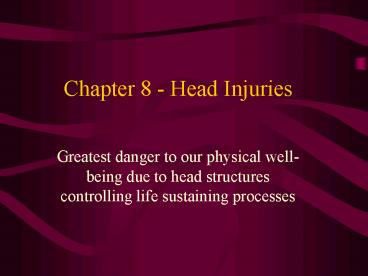Chapter 8 - Head Injuries - PowerPoint PPT Presentation
1 / 22
Title:
Chapter 8 - Head Injuries
Description:
Chapter 8 - Head Injuries. Greatest danger to our physical ... Hyoid. Head Anatomy. Brain. Cerebrum. two hemispheres. Frontal. parietal. temporal. occipital ... – PowerPoint PPT presentation
Number of Views:57
Avg rating:3.0/5.0
Title: Chapter 8 - Head Injuries
1
Chapter 8 - Head Injuries
- Greatest danger to our physical well-being due to
head structures controlling life sustaining
processes
2
Head Anatomy
- Skull
- 29 bones
- 8 cranial
- 14 facial
- 7 ear
- Hyoid
3
Head Anatomy
- Brain
- Cerebrum
- two hemispheres
- Frontal
- parietal
- temporal
- occipital
- Meninges
- Dura matter
- Arachoid Sub arachoid space (CSF)
- Pia
4
Head Anatomy
- Brain stem (relays sensory and motor information
and life supporting reflex center, cranial
nerves) - Midbrain
- Pons
- Medulla oblongata
- Cerebellum
- Subconscious movements
- Equilibrium posture
- Motor error detectors
- Movement patterns
- Emotional pleasure anger
5
Head Injuries
- Causes
- Sudden forces to head
- Direct
- Indirect (inertial)
- acceleration deceleration mechanism
- Head Motion
- translation
- rotation
6
Head Injuries
- Mechanical Properties
- Skull stiff yet compressible
- Brain compliant
- Internal stresses
- Strain exceeds capacity to withstand load
- Close vs. Open
- Primary and Secondary
- Severity internal damage to neural structures
- Boxing CTBE or dementia pugilistica
7
Chapter 8 - Trunk Anatomy Injuries
- Largest segment of the body (40-50 body mass).
8
Trunk Anatomy
- Bone Axial Skeleton
- Ribs
- Sternum
- Vertebrae
9
(No Transcript)
10
Trunk Injuries
- Vertebral fractures
- Major Health concern
- Proximity to spinal
- Potential to cause severe neural damage,
including death - Axial compressive loads
- T11-L3 minimal curvature, transition zone
11
Trunk Injuries
- Three Column model
- Burst fracture compression force causing
vertebrae to shatter from within - High loading rates intrusion
- Disk degeneration
- Healthy more intrusion
- Old less intrusion
12
Trunk Injuries
- Spinal Deformities
- abnormal distributions patterns or pathological
tissue adaptations - Associated with cardiopulmonary dysfunction
- Scoliosis Lateral
13
Trunk Injuries
- Kyphosis
- Sagittal plane hunchback
- Common in women
- Osteoporosis
- Prevention exercise
- Scheuermanns kyphosis changes in endplates of
growing vertebrae
- Lordosis abnormal extension (swayback)
- Lumbar area
- tilting lumbar area
- luumbosacral angle above 30 deg
14
Trunk Injuries
- Spondylolysis
- defect of the vertebrae lamina (pars articularis)
- Spondylosthesis
- translation or slippage between adjacent segments
- Five types
- Dysplastics
- Isthmic
- degenerative
- Traumatic
- Pathological
- Young athletes
- Isthmic repeated loading of pars region,
fractures
15
Trunk Injuries
- Spondylolisthesis
- older L4-L5 degeneration due to arthritis
- Young L1-S5, end plate lesions
16
Trunk Injuries
- Loads of the spinal column
- comples
- compression
- torsional - shearing
- tensile - excessive spinal motion
- Lumbar region highest forces
17
Trunk Injuries
- Disks
- viscoelastic
- annulus fibrosus
- fibrocartilage
- criss-crossed orientation
- nucleus pulposus
- 70-90 water
- mucoprotein fibers
- intrinsic pressure
- High tensile stress (Poissons)
- cartilaginous end plate
18
Trunk Injuries
- Loading during exercise
- Sit-up versus curls
19
Trunk Injuries
- Lifting
- Weight belts
- IAP
20
Trunk Injuries
- Bulging disks
- nucleus pulposus is displaced from its normal
position - Rotation stress
21
Trunk Injuries
22
Trunk Injuries
- Mechanism
- Compressive loads
- Hyperflexion with lateral bending
- nerve root disturbance
- posterolateral displacement
- Low Back Pain
- 85 undiagnosed































